Re-Austenitisation of Thin Ferrite Films in C–Mn Steels during Thermal Rebound at Continuously Cast Slab Corner Surfaces
Abstract
:1. Introduction
2. Experimental Procedure
3. Results
3.1. Hot Ductility
3.2. Quenched Microstructures after Primary Cooling
3.3. Precipitation of AlN in Ferrite and Austenite
4. Discussion
4.1. Hot Ductility
4.2. Formation of Ferrite above Ar3P
4.3. Metallography vs. Dilatometry
4.4. Ferrite Decompostion during Rebounding
4.5. Relevance to Advanced High Strength Steels (AHSS)
5. Conclusions
- The poor observed ductility in C–Mn steel at all practical unbending temperatures following a minimum primary cooling temperature of 730 °C is due to austenite grain boundary embrittlement as a result of thin ferrite film formation, which persists during rebounding to all tested temperatures and promotes the formation of detrimental AlN precipitation.
- The superior hot ductility following primary cooling to 830 °C, as opposed to a Tmin of 730 °C, is attributed to the absence of both thin ferrite films and AlN precipitation, as predicted by TC-PRISMA.
Author Contributions
Funding
Data Availability Statement
Acknowledgments
Conflicts of Interest
References
- Schrewe, H.F. Strand mechanics, bending, straightening and bulging. In Continuous Casting of Steel: Fundamental Principles and Practice; Verlag Stahleisen: Düsseldorf, Germany, 1987; pp. 138–144. ISBN 3-514-00389-0. [Google Scholar]
- Mintz, B.; Yue, S.; Jonas, J.J. Hot ductility of steels and its relationship to the problem of transverse cracking during continuous casting. Int. Mater. Rev. 1991, 36, 187–220. [Google Scholar] [CrossRef]
- Abushosha, R.; Ayyad, S.; Mintz, B. Influence of cooling rate on hot ductility of C-Mn-Al and C-Mn-Nb-Al steels. Mater. Sci. Technol. 1998, 14, 346–351. [Google Scholar] [CrossRef]
- Nozaki, T.; Matsuno, J.; Murata, K.; Ooi, H.; Kodama, M. A secondary cooling pattern for preventing surface cracks on continuous casting slab. Trans. ISIJ 1978, 18, 330–338. [Google Scholar] [CrossRef] [Green Version]
- Coleman, T.H.; Wilcox, J.R. Transverse cracking in continuously cast HSLA slabs–influence of composition. Mater. Sci. Technol. 1985, 1, 80–83. [Google Scholar] [CrossRef]
- Suzuki, K.; Miyagawa, S.; Saito, Y.; Shiotani, K. Effect of microalloyed nitride forming elements on precipitation of carbonitride and high temperature ductility of continuously cast low carbon Nb containing steel slab. ISIJ Int. 1995, 35, 34–41. [Google Scholar] [CrossRef] [Green Version]
- Lekganyane, K.M.; Mostert, R.J.; Siyasiya, C.W.; Banks, K.M. Irreversible loss of hot ductility following simulated primary cooling of a C–Mn steel to temperatures above the ferrite transformation temperature. Mater. Sci. Eng. A 2021, 810, 141007. [Google Scholar] [CrossRef]
- Lekganyane, K.M. Influence of primary cooling conditions and austenite conditioning on the hot ductility of simulated continuous cast peritectic steels. Master’s Thesis, Dept. of Materials Science and Metallurgical Engineering, University of Pretoria, Pretoria, South Africa, 2020. [Google Scholar]
- Andersson, J.O.; Helander, T.; Höglund, L.; Shi, P.F.; Sundman, B. Thermo-Calc version 2022b and DICTRA, Computational tools for materials science. Calphad 2002, 26, 273–312. [Google Scholar] [CrossRef]
- Mintz, B. The Influence of Composition on the Hot Ductility of Steels and to the Problem of Transverse Cracking. ISIJ Int. 1999, 39, 833–855. [Google Scholar] [CrossRef]
- Vander Voot, G.F. Atlas of Time-Temperature Diagrams for Irons and Steels; ASM International: Reading, PA, USA, 1991; p. 13. ISBN 0-87170-415-3. [Google Scholar]
- Aranas, C., Jr.; Grewal, R.; Chadha, K.; Shahriari, D.; Jahazi, M.; Jonas, J.J. Formation of widmanstätten ferrite in a C-Mn steel at temperatures high in the austenite phase field. In Proceedings of the International Conference on Solid-Solid Phase Transformations in Inorganic Materials (PTM 2015), Whistler, BC, Canada, 28 June–3 July 2015; pp. 613–620. [Google Scholar]
- Wilson, F.G.; Gladman, T. Aluminium nitride in steel. Int. Mater. Rev. 1988, 33, 221–287. [Google Scholar] [CrossRef]
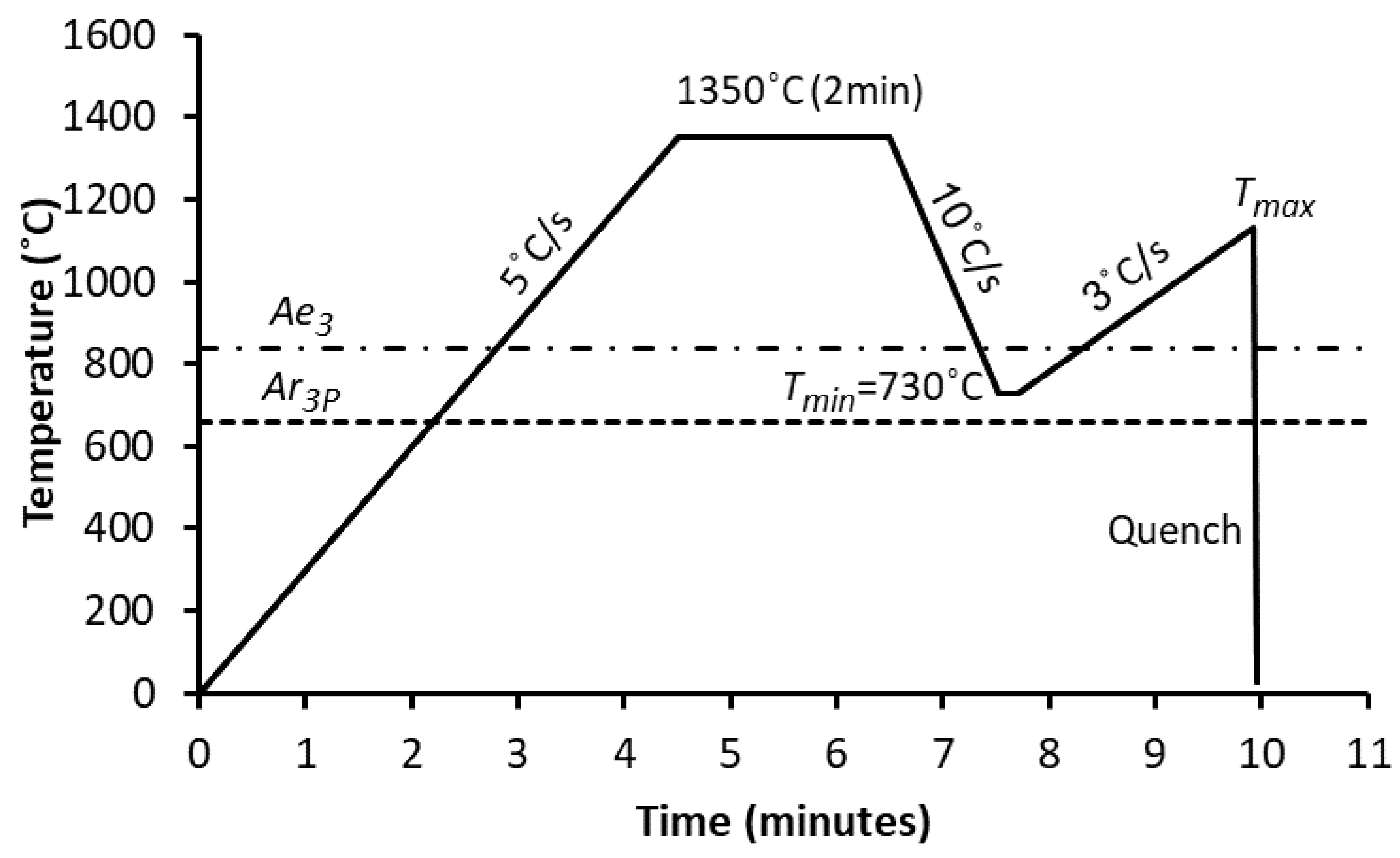
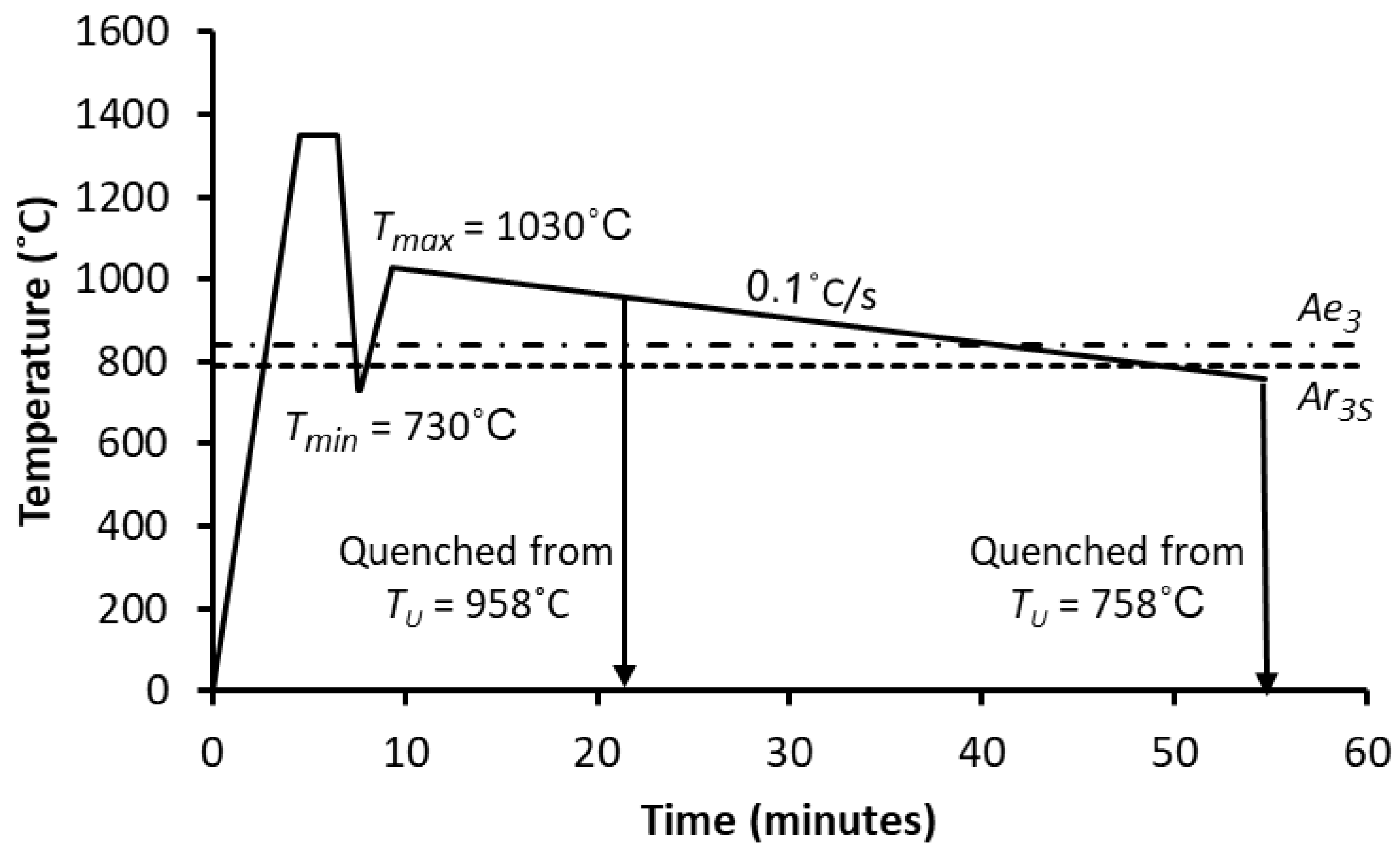
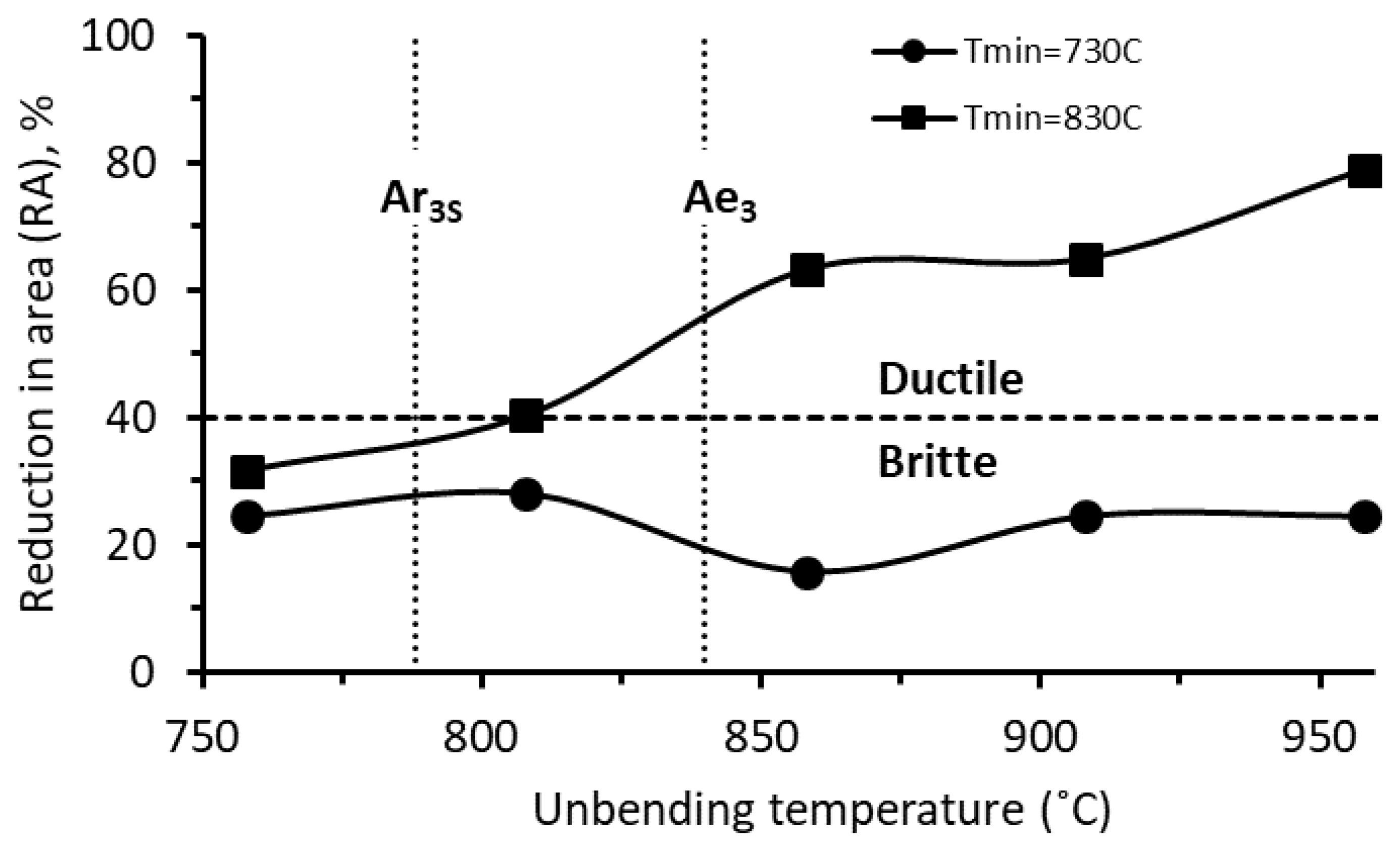

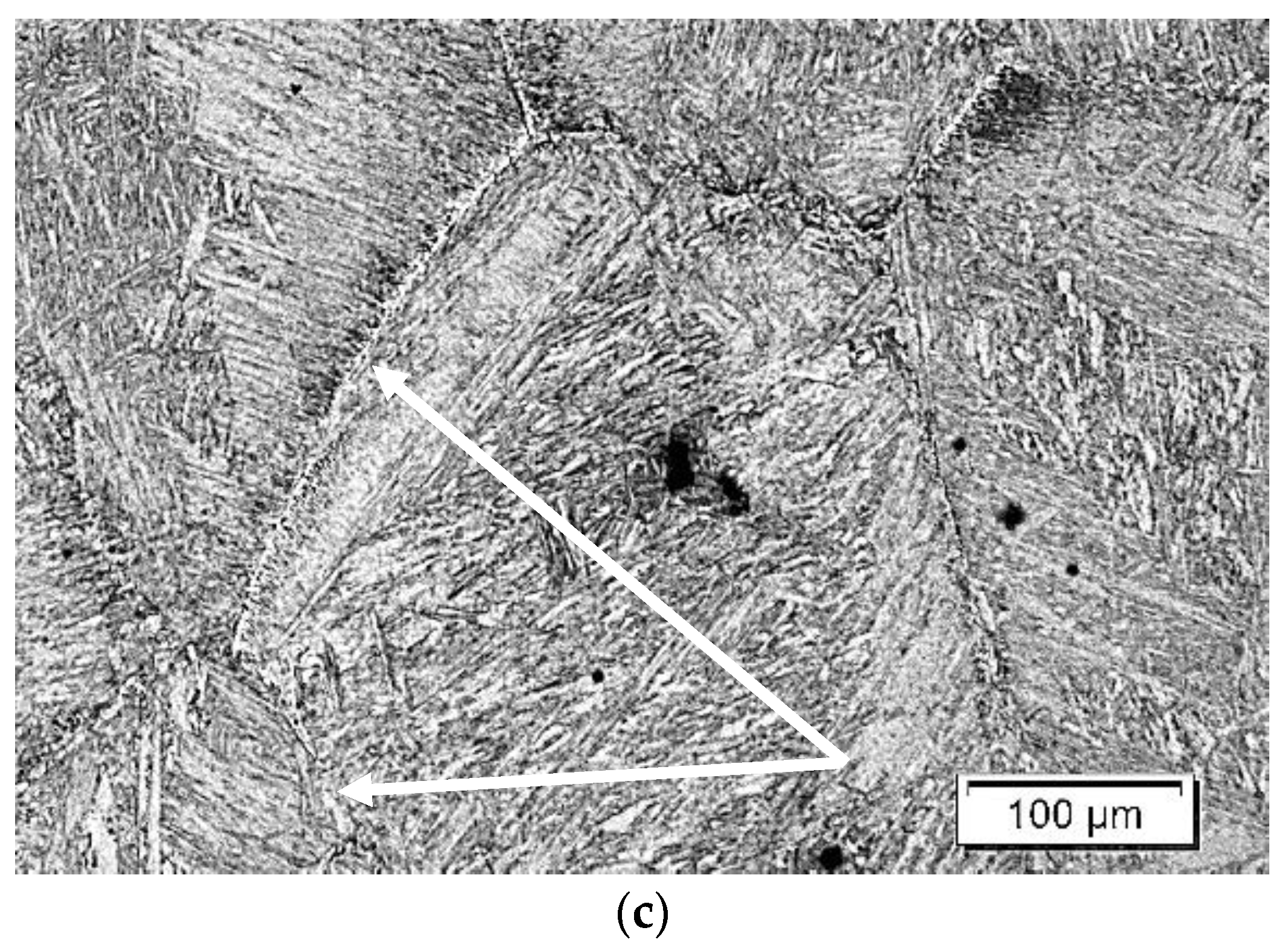




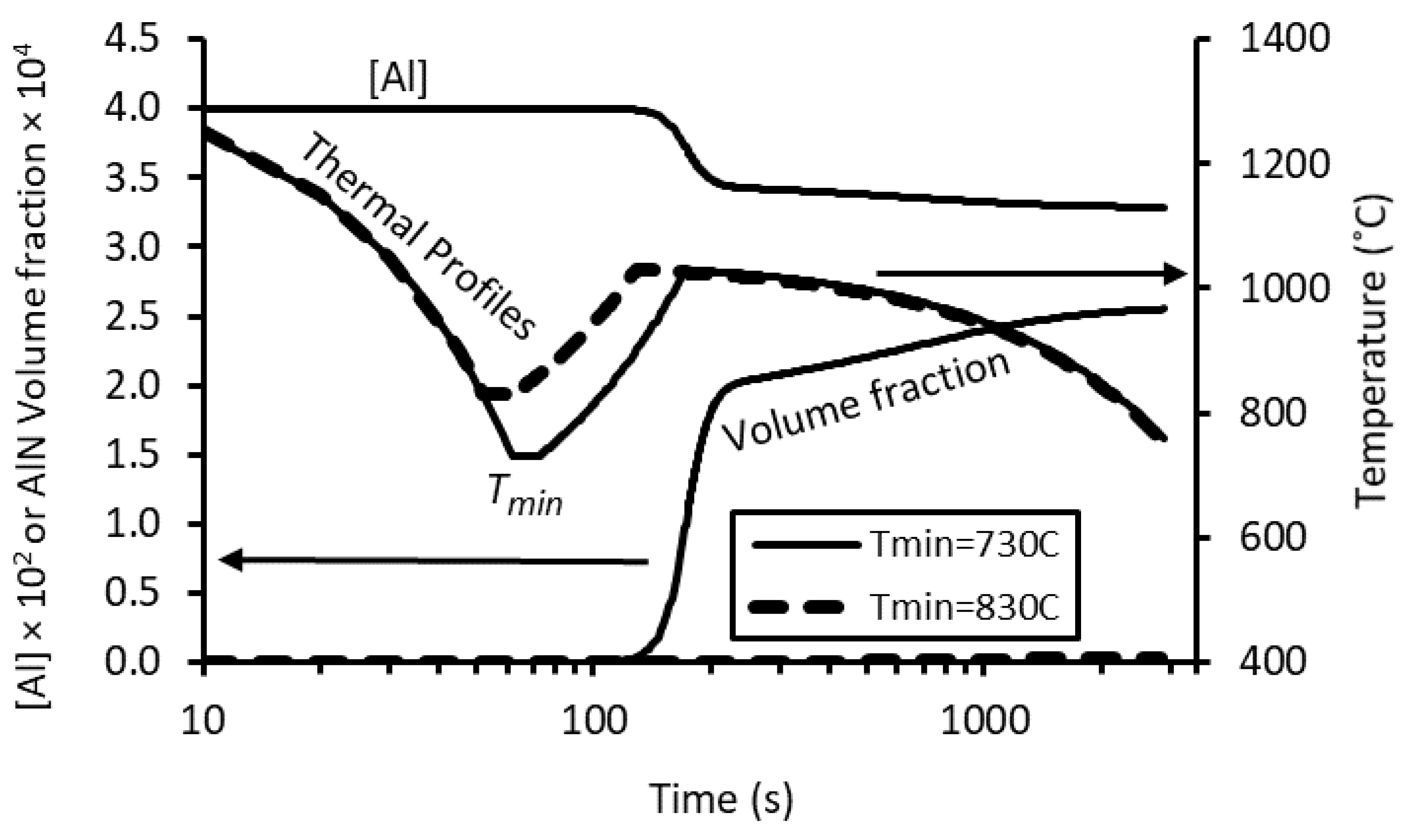


| C | Mn | Si | Ni | Cr | P | Al | N | S |
|---|---|---|---|---|---|---|---|---|
| 0.16 | 1.03 | 0.06 | 0.01 | 0.02 | 0.01 | 0.04 | 0.0037 | 0.0030 |
Publisher’s Note: MDPI stays neutral with regard to jurisdictional claims in published maps and institutional affiliations. |
© 2022 by the authors. Licensee MDPI, Basel, Switzerland. This article is an open access article distributed under the terms and conditions of the Creative Commons Attribution (CC BY) license (https://creativecommons.org/licenses/by/4.0/).
Share and Cite
Maubane, D.R.N.; Mostert, R.J.; Banks, K.M. Re-Austenitisation of Thin Ferrite Films in C–Mn Steels during Thermal Rebound at Continuously Cast Slab Corner Surfaces. Metals 2022, 12, 2155. https://doi.org/10.3390/met12122155
Maubane DRN, Mostert RJ, Banks KM. Re-Austenitisation of Thin Ferrite Films in C–Mn Steels during Thermal Rebound at Continuously Cast Slab Corner Surfaces. Metals. 2022; 12(12):2155. https://doi.org/10.3390/met12122155
Chicago/Turabian StyleMaubane, Dannis Rorisang Nkarapa, Roelf Johannes Mostert, and Kevin Mark Banks. 2022. "Re-Austenitisation of Thin Ferrite Films in C–Mn Steels during Thermal Rebound at Continuously Cast Slab Corner Surfaces" Metals 12, no. 12: 2155. https://doi.org/10.3390/met12122155





